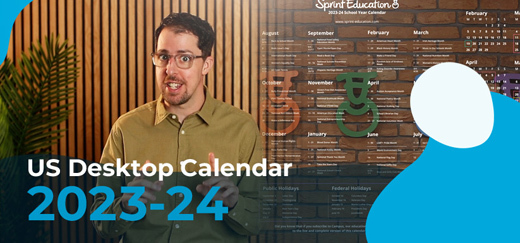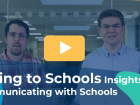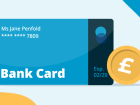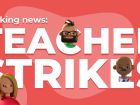The State of Selling to Schools 2023
The State of Selling to Schools 2023
Read the third edition of our groundbreaking report, and get essential education insights from 5,870 teachers to help you sell more to schools.
Read the third edition of our groundbreaking report, and get essential education insights from 5,870 teachers to help you sell more to schools.
Introduction
We’re delivering our third annual ‘State of Selling to Schools’ report in much different – and positive - circumstances from our previous reports. 2022 had begun tentatively with the pandemic still making its mark, but ended with schools once again humming with the sounds of students back on site interacting with their peers and teachers, and 2023 is already shaping up to be a much more optimistic year.
But schools rarely stand still, and no two years are the same, which makes Sprint Education’s role in being up to date with educational trends all the more important.
This year’s report has been compiled by the Education Team, who keep their eyes on the horizon and our whole team up to speed in everything that is happening within the world of education. No matter how calm or choppy the waters of education marketing are this year, with this report as your compass, you can find your path for the year ahead.
Why read this report?
This year’s report is our biggest yet!
This year saw the most responses ever to our survey, with 5,866 completions. This is a steep increase from 3,210 in 2022, and 2,600 in 2021, making the results more representative of the educators surveyed.
The report combines insights into schools’ problems and priorities for the year ahead, and draws comparisons with last year’s survey results, where applicable. Our deep analysis draws new conclusions about selling to schools, with a new heightened focus on wellbeing and EdTech, all to help you shape your marketing strategy, solve schools’ problems, and make more sales.
About the Authors
Our Education Team, Ben Sawyer and Lance Martin, have nearly 30 years’ of school experience between them.
Lance, our Education Specialist, qualified as a teacher in 2014 and has been a real jack-of-all-trades in the classroom. During his time at Pakuranga College in New Zealand, he taught ESL, History, and Social Studies, becoming Head of their History and Social Studies departments; and supported the school as a cross-curricular learning coach for five years.
Ben has been a music teacher and Head of Music and Performing Arts for 20 years. He has worked in some wildly different schools over that time in both the state and independent sectors, always making his mark through his love of singing, his ability to engage and enthuse young people, and a meticulous approach and attention to detail. He brings this wealth of experience to our role of ‘Head of Education’.
Chapter 1 - Who completed our survey?
Before we delve into the nuts and bolts of this year’s report, it’s important to know who’s involved in the research. This section is broken down into four questions, zoning in on the educator’s job role and additional responsibilities, as well as the type of establishment they work at, and the age range it covers.
Which best describes your role?
A combination of Class Teachers and Subject Teachers provided over a third of replies (35.1%). But over a quarter of all participants were Heads of Department (25.9%), and Senior Leaders, another key decision-maker, also made up a sizeable portion of our audience (16.5%).
The vast majority of respondents are teaching staff, or work directly in supporting pupils and students in their personal and academic development. This means we’re hearing directly from the primary users when it comes to education resources, and key decision-makers regarding a school’s fabric and day to day running, such as Heads of Department, Curriculum Leads, Heads of Year, and Key Stage, and Senior Leaders.
Which best describes your additional responsibilities?
New for 2023, we asked staff to share with us which responsibilities they have on top of their regular job role. In many schools, particularly those which are smaller or underfunded, it’s not uncommon for staff to ‘double up’ on their responsibilities. A Class Teacher may also be the school’s Wellbeing Lead, and members of the Senior Leadership Team are often Safeguarding Leads. This question provides more insight into who the main decision-makers are in several key areas.
Of those that responded, 31.3% provide an enrichment activity in school. Enrichment activities provide pupils with a more rounded, culturally rich education through activities that enhance their learning, and often relate to student wellbeing activities, for which 22.6% of respondents have some responsibility. Student support roles also feature strongly, with Student support, Safeguarding, SEN support and Gifted and Talented selected by 62.5% in this multiple choice question.
46.2% of teachers have responsibility as Curriculum Lead. This could be a Head of Department in a Secondary School or Independent Junior School, where staff members hold subject specialisms. In a Primary School, the Curriculum Lead would likely be one of the Class Teachers, who hold additional responsibilities in one subject area to support the school.
This demonstrates the opportunities available in targeting teachers to influence decision-makers in school. It is also worth noting that in a wide variety of ‘other’ responses, when respondents were asked to provide additional information, pastoral roles, exams and business and finance responsibilities all feature. This goes to show that job roles in education are often varied and complex, with teaching lessons just one part of a teacher’s working day.
Which are range does the establishment you work in cover?
New for 2023, this question will provide us with a more precise insight into the background of the respondent. By knowing which age range our respondents work with, we can more accurately connect businesses with the correct schools to fit their product or service.
Secondary Schools and Primary Schools were by far the most popular answers, making up 54.4% and 31.5% of the audience respectively. Considering roughly 78% of UK schools are Primary or Secondary, this tallies up with what we’d expect to see.
Which type of establishment do you work in?
By asking about different age ranges, we were able to find out more accurately the types of schools at which respondents work. In 2022, just 5.1% responded with Multi-Academy Trust but in this year’s survey, that figure has leapt to 29.6%. This may relate to progress being made towards the recently-scrapped Department for Education’s target for all schools to be part of a Multi-Academy Trust by 2030.
In addition to this, we have widened the scope of types of school this year. For the first time, we have figures of those that work in Faith Schools. These are quite often Church of England Primary Schools, but also include Catholic and other Multi-Faith schools, and total 9.7% of respondents. The Independent sector is well-represented too, with 21.5% working in an Independent or Public School compared to 11.3% from 2022. SEN Schools and Pupil Referral Units can be found in the bottom 4% of our findings, as can Grammar Schools (which are often selective), State Boarding Schools and City Technology Colleges. As schools were the primary focus of our survey, Universities are in the bottom 1%.
These two questions will all contribute to connecting you with your target audience, and in turn help us to provide you with the most accurate guidance.
“Knowing who to send your marketing to is a key question when putting your campaign into action. By asking respondents their roles, responsibilities, school age ranges and types of establishment, it shows what a wide spectrum the education sector encompasses. What you have here is a great list of the primary users and decision-makers in schools. If you have a fantastic teaching resource, then it is the teachers you want to target, as they will ultimately be the ones to be implementing this in the classroom. If you have an engaging enrichment activity, then those with responsibility for extra-curricular clubs should be your first port of call. They may not hold the purse strings, but as your primary users, they will be the ones to pass these decisions up to the people that do. There are over 571K education staff members across 31K schools you can reach during your next schools strategy. To start making greater connections, and more sales, call us today on 01684 297374.”
Stuart Morris, Head of Campaigns
Chapter 2 – Communicating with schools
For the third year running, the result was overwhelming.
A massive 87.6% of respondents are most likely to respond to an email!
Once again, this underlines the importance of a strong, strategic email campaign.
As we have stated in previous reports, email communication is an effective but unobtrusive way to engage with teachers. We only ever email teachers’ work email accounts about products and services that will benefit their school.
The benefit of emailing work-only addresses is that teachers actively need to log into their work account. They will be expecting emails related to their job, and they will in all likelihood be in the right frame of mind to engage with this kind of content.
Emails are also quick to delete, and all emails sent by Sprint Education are simple to unsubscribe from – it just takes two clicks for a teacher to remove themselves from all our future communications, something that gives them a sense of control over the content they receive.
The option to quickly opt-out is not as simple for all the other communication methods listed, particularly social media.
While social media campaigns can be highly effective in other sectors, it’s clearly the least-favoured method of communication for teachers, with communication via Twitter, Facebook, and LinkedIn receiving less than 4% of combined survey responses.
Social media is mostly used by people to connect with friends and family during their downtime. Therefore, it’s less likely that teachers will be as keen to engage with marketing messages when not in ‘work mode’.
It’s important, though, not to undermine the importance of physical publications and postal campaigns, with schools returning to ‘business as usual’. Education publication adverts have become more important, moving up from third place in 2023 with just 1.8% of the votes, up to second this year with 5%. Teachers are getting back into the habit of flicking through their favourite publications to source inspiration and support, and the easing of COVID restrictions likely means the staff room coffee table is once again filled with plenty of publications for staff to share around.
Although it’s moved into third spot, postal correspondence has dropped slightly from 3.9% in 2022 to 3.6% in 2023.
These results, for the third year running, back up our expert insights that email marketing is the key to unlocking success within the education sector.
“We invest over £750k every year in the continual development and management of our technical infrastructure to ensure our clients get the best results possible. Our technical infrastructure is the most advanced in our sector. We are the only education marketing agency to own, host, and manage our servers/IPs in-house. This means we are in complete control of our clients' email paths which ensures a much better deliverability rate. Get in touch with us today on info@sprint-education.co.uk to learn more about how we guarantee your emails have the best chance of success”.
Guy Lewis, Co-Founder
How often do you check these social/communication tools each day?
When it comes to frequency of views, email is king!
46.8% of teachers surveyed said they check their work email more than ten times a day.
The number of respondents that check their work email more than 10 times a day has gone up since our last survey. In 2022, this figure topped the matrix results with 46%, slightly increasing to 46.8% this year.
Facebook is the second communication tool that teachers engage with most regularly, but it trails far behind email, with just 3% of teachers saying they check it more than ten times a day. Of course, there’s nothing to suggest they’re checking their social media feeds for work purposes, so these could all purely be for entertainment.
Applied across the whole UK sector, this equates to nearly 5,387,000 more inbox logins than Facebook views by UK teachers each day. That’s 1.97 billion more across one calendar year!
A closer look at the numbers show that teachers check their inbox an average of 8.3 times per day, and view their Facebook feed 2.75 per day. These numbers are extremely close to our findings from 2022.
Teacher workload continues to be a hot topic, and one of the key reasons that teachers voted to take strike action in February and March 2023. Whatever solution is found in the short term, the longer-term issue is not likely to disappear overnight. For teachers to have resources at their fingertips via email is all the more important considering the pressure that those working in schools are continually under.
Teachers will naturally be checking their inboxes anyway as they correspond with colleagues or parents. However, if you can highlight how important your offer is concerning their day-to-day work, perhaps even topics they’re emailing their colleagues about as your email hits, your email is bound to gain attention.
Sending postal campaigns to staff pigeon holes is still an effective method of communication, with 35% visiting their pigeon hole 1-3 times a day, and 59.9% less than once a day (some of which could simply be due to the fact not every teacher works full time). For many staff, it remains a daily habit, and one you should certainly take advantage of with your selling-to-school strategies.
For teaching staff, checking their pigeon holes once a day is not the same as scrolling their Twitter feed once a day. The power of something that can be held in the palm of your hand cannot be underestimated, particularly given the vast difference in quantity – and quality – between the two mediums.
If your pigeon hole campaign captures teachers’ imagination, they are likely to engage with it on a far deeper level, something that can be seen in the increase of likelihood for teachers to respond to an education publication advert.
How likely are you to react positively to the following communications sent to you from an education service provider?
The financial pressures on schools become increasingly more evident during this area of research.
Special offers, free trials, free webinars and competitions all score highly in the ‘likely’ column, and the number that say they would ‘definitely’ respond to a special offer or discount has risen from 3.7% in 2022 to 5.8% in 2023.
What seems less and less popular is the offer of a phone call to discuss solutions. 73.8% of respondents said they were ‘unlikely to’ or would ‘definitely not’ respond to the offer of a telephone call, up from 70.4% in 2022. This can be seen as an indicator of the time and workload pressures those that work in schools currently feel under. Teachers can respond to email as and when they have time to, rather than committing time to a phone call. Teaching staff would be unable to schedule a call during teaching hours, leaving them with the unfavourable option of lunchtime or afterschool only – neither of which would support their wellbeing and stress levels.
“This again reinforces the fact that email is by far the best way to communicate with teachers, as they’re much more likely to respond to your communications at a time that suits them. This makes that eye-catching email all the more important. And that could sometimes be a straight-to-the-point text-only email with content that really grabs the reader. Get in touch with us on 01684 297374 for advice on the best way to approach your email campaign to give your world-class product or service the strongest chance of success!”
Ben Sawyer, Head of Education
Chapter 3 – Connecting with schools
Engagement comes first, but how do you turn those initial conversations into meetings? We asked the all-important questions about when educators are free to discuss your solution further. When is the most convenient time for you to be able to connect with an education supplier?
When it comes to connecting with teachers, after school is understandably the most popular time, with a minimum 44% of respondents selecting this option regardless of the means of communication. Online training/workshops were the most popular method for after-school correspondence, with 54.7% selecting this time. This overlaps with when many establishments could be carrying out professional development, supported by the finding that in-person training/workshops were also high at 49.1%.
The preference for connecting with suppliers after school reflects the packed schedule during a teaching day, with classroom teachers especially giving their full attention to their pupils from when the first bell rings in the morning, until the end of the teaching day.
There are exceptions, such as teachers arriving early to check their emails before school (12.2%) or during the day when teachers have scheduled non-contact time between classes. These times vary from teacher to teacher, and are reflected in the 28.2% who said they were happy to be contacted anytime by email. This again is far higher than by any other means of communication; the next closest method teachers would be happy to receive anytime was in-person training/workshops at a significantly lower 13.6%.
To maximise your education reach, it’s vital you take advantage of this after school period between the final lesson and when they leave for the day, where they’re likely to be sat at their devices completing administration tasks (including working through their inbox). For many schools, the golden hours would be during 4pm-6pm – although keep in mind the staff wellbeing initiatives that aim to help teachers leave as soon as possible after lessons finish, usually between 3-3:45pm.
When it comes to being contacted via email, 28.2% said they could be contacted anytime, speaking to the preferences for using their own inboxes. Email also had the smallest percentage of teachers who said they would never like to be contacted by that means (7.9%). 31.7% and 28% of educators respectively would never like to be contacted by video call or phone call.
How much notice should be given by an education supplier for each item listed?
Regarding the notice education suppliers should give for each means of connection, the voice is loud and clear: having 1-3 months’ notice is best. This response was especially high for in-person training, external training days, and carrying out a workshop or assembly – all events that would understandably need a fair amount of organisation.
The only items with shorter preferences were a free webinar or eLearning/EdTech demo, both of which had higher responses for 2-4 weeks’ notice at 48% and 41.1% respectively (and both of which require substantially less planning and fewer participants than the above three events).
Trip planning, of course, required the greatest time consideration, with 45.7% of respondents needing more than 4 months to over a year to prepare.
Across all the items, on average, 71% of purchasing decisions are made by teachers over a period of between 2 weeks to 3 months’ notice. This is down to the involvement of more than one member of staff in many decisions, as wider staff buy-in leads to more time needed to consider service options.
“Effective communication requires consideration for the working patterns of education staff. You may have big promises, such as ‘how your webinar could reveal the key secrets to guaranteeing an Outstanding Ofsted inspection’, but if you scheduled it for 10am on a Tuesday in the middle of term time, most of your audience would have to miss it. This is where a strategy of at least three emails is vital rather than a single email. It is always best to alert your audience to your offer early, make sure they have all the details, and finally follow them up with a reminder. For assistance planning your next three-phase strategy, contact our education experts on info@sprint-education.co.uk.”
Rebecca Weatherley-Hastings, Copywriter
Chapter 4 – Wellbeing in Schools
In 2022, we asked how those working in education ranked their stress levels at that moment. This year we’ve shifted the focus of our questions to ask:
How well does your establishment provide for the wellbeing of staff?
Emotional and Mental Wellbeing scored highly in the top priorities of establishments. Having said that, the feeling of staff was that, on average, they would give 6.5/10 to wellbeing provision. Of the 5,866 people that responded to this question, however, 2,177 or 37.3% scored 8 or higher. This comes nearly two years after the Education Staff Wellbeing Charter was published by the Department for Education, a free resource that in reality had only been signed up to by one in ten schools by January 2023. Various examples of provision for staff include providing wellbeing training, improving the school environment and taking team building seriously.
“It’s fair to say that over the last three years, teachers and school staff have witnessed the biggest upheaval across the education sector in living memory. But since we published our first State of Selling to Schools survey highlighting the high stress levels teachers were experiencing, many of our clients have swung into action with truly inspiring campaigns designed to support their customer base, with some equally inspiring opening and click-to-open rates to boot. Want to know how they did it, and level up your support for teachers in 2023? Email info@sprint-education.co.uk, or call 01684 297373, and we’ll manage every aspect of your next education marketing strategy.”
John Smith, VP of Operations
How well does your establishment support the wellbeing of students?
The response to the question ‘How well does your establishment support the wellbeing of students?’ was more positive. Respondents gave an average score of 8.1/10 for how well their establishment supports its students, and of the 5,866 that answered this question, 4,253 or 72.8% gave a score of 8 or higher. This is a strong endorsement of how educators feel their establishment is looking after their young people. This may be a result of the numerous initiatives to support student wellbeing, such as the Healthy Schools programme, Active Schools+, Pupil Voice, and strong PSHE programmes. This is in addition to the huge variety of extra-curricular activities that schools provide through music, clubs, sports, and a huge range of other activities.
However, while 8.1/10 is much higher for students, there is still room for improvement. Students are more exposed to online threats to their mental wellbeing than previously, so further support in this area is now a necessity. Days such as ‘Internet Safety Day’ in February, which falls during Children’s Mental Health Week, are important opportunities to deliver more effective resources and training for strengthening a school’s wellbeing programme.
These are broad-answer questions, and there is a lot more to be discovered about how schools are approaching the important topic of staff and student wellbeing. What can be seen is that schools do take these areas very seriously, particularly in the wake of the disruption caused by the COVID-19 pandemic. We know too that the ongoing backdrop of strike action and disputes between unions and the government will be adding to the already high stress levels being experienced by those working in education. Therefore, if you have a resource that can address points made in the government’s Wellbeing Charter , by keeping a close eye on the Wellbeing section of the Campus Calendar in its Education Insights module, you will be well on the way to delivering a product that would be difficult to ignore.
Chapter 5 – EdTech in Schools
A new section for 2023, these two questions aim to scratch beneath the surface to explore how EdTech tools and eLearning approaches are being adopted and implemented.
EdTech refers to any digital tool, application, or online learning platform that can support students in their education. For instance, EdTech can be used to:
- Differentiate learning experiences by individual need.
- Provide engaging methods of acquiring and reviewing knowledge.
- Gather and analyse assessment data.
- Enable collaboration on a wider project.
- Acquire live feedback from students to understand their progress.
- Allow for new methods of learning, such as a flipped classroom.
EdTech is one of the largest, fastest-growing areas of education today, and the potential for its use in the classroom is vast. Educators’ opinions are vital to help you stay at the forefront – and even deliver - some potentially ground-breaking advancements.
To what extent do you feel your establishment embraces new developments in EdTech? E.g. The online and in-person digital learning tools that support the teaching, preparation and delivery of content in your classroom.
Distance learning and EdTech have undergone something of a revolution since 2020. For many establishments, EdTech became a necessity for teaching via distance learning. Indeed, 51% of State Primary and 82% of State Secondary teachers were directing pupils to digital platforms during lockdown learning. As a consequence, EdTech – specifically online and in-person digital learning tools – have increased in popularity with teachers. Even teachers who were less convinced by the benefits of technology or had less experience of using it have now had a chance to use and experience EdTech, and can see the positive impact it has - so much so that a new discussion around the continued use of EdTech back in schools is leading to new and successful teaching practices.
Blended learning - combining traditional face to face teaching with digital and online approaches - continues to grow in relevance. EdTech can help to solve the short-term and long-term challenges that a school faces. Short-term uses can include managing the needs around unplanned school closures, for example, due to a dangerous weather event. In the long run, blended learning could be used to share expertise across institutions and even borders without the need for staff to travel. Many schools are exploring how EdTech can facilitate a wider move to a full time blended learning approach.
From this question, we can see 62.3% of educators believe their establishment embraces new EdTech developments. This reflects the fact that they have undergone a period of school-wide upskilling in the use of EdTech, and are now more open and able to take advantage of future tools that can support the teaching of students and running of schools.
In which areas of your role do you find EdTech most beneficial?
For this question, we can break down the use of EdTech further. For instance, we can see that day-to-day tasks that can be completed digitally are the most popular with respondents, including for the means of managing communication (41.6%) or attendance (30.6%), or as part of their Learning Management System (35.8%).
A Learning Management System, or LMS, is an EdTech tool that allows teachers to connect with students, share resources, and monitor participation among other functions, often seen as the ‘digital version’ of a physical classroom.
EdTech designed to support the efficient completion of learning tasks and give teachers more time to fulfil other roles in the classroom were also popular, with over 3,600 saying tools that help with independent study and revision, as well as formative and summative assessment completion, are the most beneficial. Workload has been consistently cited by teachers discussing their reasons for striking in early 2023, with many working extra hours to complete administrative tasks and lesson preparation. EdTech solutions providers can highlight the benefits of their tool for saving teachers time and automating some administrative tasks around assigning, marking and reporting on student work.
An area of EdTech that has the potential for growth is the extent to which it is used to support different approaches to teaching. As we can see, fewer than 20% found differentiation, collaboration, or flipped learning methods most beneficial. However, 24.7% saw EdTech as supporting greater classroom engagement, and gamification of learning. This shows a preference for EdTech tools that develop interest amongst students through low-stake competition, or that make learning content more interactive.
“There is much more to find out about EdTech and how educators at all levels are using it to redefine or evolve their school’s approach, and we at Sprint Education will remain at the forefront of exploring and sharing the opportunities available to education suppliers. We can already see that there are clear opportunities available to EdTech and ICT solutions providers. Now is the time to share your solution, and use the recent eLearning revolution as a springboard to engage with more schools. Why not share with schools how you can support them to drive long-lasting changes in their approach to learning? Show them not just how the organisation and management of learning can be improved, but how this can translate to modern learning approaches in the classroom. Does your education solution have a digital element to it that can support in-person and/or online learning? If so, are you making the most of how you share these benefits with our respondents? If the answer is no, 2023 should be the year that you start emphasising the full potential of your EdTech solution. Call Sprint Education on 01684 297374, and we’ll help you make it happen.”
Lance Martin, Education Specialist
Chapter 6 – 2022/2023 purchasing
While the results above give us a good overview of how to engage schools with your marketing efforts, this chapter will explain where they spent their budget over the last year, and, crucially, what their priorities are for the year ahead.
Are you a decision-maker with budget responsibility at your establishment?
For the first time, we have directed a set of questions at a specific group: the financial decision-makers in schools.
This year, we have been able to get straight to the key people with budget responsibility when it comes to what, when, and why spending decisions are made in schools.
What is interesting to note, however, is the diversity of roles that fall into this group.
While this a ‘yes or no’ answer question, a closer look at who said ‘yes’ and who said ‘no’ gives us a further insight into the complexity of roles within schools. 38.5%, or 2,254 respondents, answered ‘yes’ to being a decision-maker with budget responsibility, and the following questions were only answered by this specialised group. Of those that answered ‘yes’, 1,779 are Heads of Department, Heads of Year or Key Stage or Senior Leaders (including Head Teachers). That’s just over 79% of that cohort. The ‘no’ answers, making up the remaining 61.5%, were more heavily weighted to Class and Subject Teachers, totalling just over 50% of that number. Surprisingly, just over 31% of those that answered ‘no’ were in the group that voted so strongly ‘yes’, the Heads of Department, Heads of Year, and Key Stage or Senior Leaders. This is an interesting contradiction, but as mentioned above, those that chose to answer ‘no’ may feel that their role is not specific to budgets.
By cross-referencing ‘yes’ answers with those from our question of their additional responsibilities (see Chapter 1 - Who completed our survey?), we find that over 45% (817) have a responsibility as Curriculum Lead. Of those, 119 work in Primary Schools, and 596 as Heads of Department in Secondary School. These are the people that will be keeping the closest eye on what is being taught in the classroom day-to-day.
What we have is a strong sample of school and wider staff that take a particular interest and have responsibility for how their school spends their budget, and these are the perfect group to take us forward into the next part of the survey.
In which area did your school increase its spending during 2022?
This is a question where comparing results from 2022 to 2023 show how priorities have shifted in education establishments as restrictions from COVID-19 no longer impact day-to-day life in school. With Attainment and Results at the top of schools’ priorities for 2023 (see Chapter 9 – Goals and Priorities for 2023), it comes as little surprise that teaching resources and equipment sits at the top of the list. 35.6% of respondents say that their school increased spending in this area in 2022. The use of supply teachers has also jumped up by nearly 8% from 23.9% to 31.8%, reflecting the fact that in-person lessons are now back to being closer to what we know as ‘business as usual’. A delve into the ‘other’ answers, where respondents were asked to provide more clarity, revealed a few interesting facts. Heads of Department, for instance, don’t necessarily have the bigger school-wide picture, due to their primary focus being their own area of expertise. The cost-of-living crisis also factored in, with around 1% bringing this up an impact on the areas in which their spending increased.
In which area did your school decrease its spending during 2022?
The top answer for the question of where establishments decreased spending was, for the second year, supply teachers.
This may seem to contradict the results of the previous question, but it shows that different establishments deal with these issues in different ways. Schools often have a cover rota or designated cover supervisors to step in to cover teacher absence. It is also an indicator that supply teachers are themselves in short supply.
What is less of a surprise is that 18.5% said their establishment had dropped in spending on distance learning as students move back into their classrooms full time. However, schools will have fairly recently made their big purchases in this area, so this is likely not a top priority for the time being. You can read more on this in Chapter 5 - EdTech.
Another area where respondents reported a drop in spending was training, up to 17.2% from 12.4%, though this is further down the list this year. This could be another reflection of the workload faced by teaching staff in the school recruitment and retention crisis. This is highlighted in the National Foundation for Education Research’s recruitment and retention in England dashboard.
In which area do you predict your school will increase its spending during 2023?
It remains unsurprising that, with so many schools prioritising attainment and results, that teaching resources and equipment at 35.8% should also be at the top of this chart, predicting what establishments will be increasing their spending during 2023.
Additional learning support will potentially see an increase in 27.2% of schools. This overlaps somewhat with tutoring, something we’ll explore further when looking at predicted decreases in spending for 2023. 27.3% of decision-makers believe operations and maintenance would see an increase in spending. This could be a reflection on the cost-of-living crisis, with a number of people highlighting this in ‘other’ comments.
In which area do you predict your school will decrease its spending during 2023?
Areas where schools might decrease spending are more evenly spread, with 10% separating supply teachers on 23.6% at the top of this multiple-choice list, and tutoring on 13.6% in sixth place.
This is another indication of funding pressures faced by schools. A look at the full survey shows that a good number of respondents gave multiple responses on this question, giving the impression that they felt that spending was likely to decrease in multiple areas. In recent years, tutoring has received extra government funding to combat the impacts of learning loss from the pandemic, as we saw last year when 26.7% expected an increase in its funding. However, this has now dropped down the list of where establishments predicted they might increase spending and is now at only 9.6%. This could be down to budget holders already accounting for the funding previously made available through the National Tutoring Programme as a part of their spending prediction. For the school year 2022-23, £349 million of core tutoring funding was made available directly to schools, showing significant funds remain in place for tutoring providers to support schools.
Global Learning loss is a key story to arise from the pandemic, with an average of a third of a year of schooling having been lost per student, according to a study by journal Nature Human Behaviour. Unfortunately, a large portion of money that the government has put towards the National Tutoring Programme has gone unspent. This has been put down to various issues, one being that the funding was only available for a year at a time, meaning longer-term planning was not possible. In addition to this, although the ‘high level of support’ was praised, there was also a ‘lack of trust’ with schools having to give detailed evidence on how they spent the tutoring cash.
With the 5% pay rise offered to teaching staff by the Department for Education in September 2022 to be taken from school budgets, money is particularly tight in schools. This obviously has knock-on effects to those that sell to schools, and comes back to the stronger likelihood of staff responding positively to special offers, discounts, or free resources. As you read further into this report, you will gain insight into how education businesses can better support and serve educational establishments in 2023.
The political backdrop of union disputes with the government are an important consideration in this section of the survey. Schools are being stretched beyond their means and the responses to our survey reflect the feeling that spending is likely to decrease in 2023. These questions do, however, provide a good rundown of the numerous areas in which budget holders make their decisions, so if your product is being affected by a decrease in spending, it would be worth your while finding a new angle from which to approach schools. For instance, if distance learning is a focus of your business, translate that into how teachers can use your technology effectively in the classroom, or consider that special offer that could start a deeper conversation into what you can provide for schools.
”We know from this report that there are huge opportunities available to education businesses who choose to pursue them. If you want to talk about any of our findings in more detail, want some tips for your next mail-marketing strategy, or want to make email marketing your top channel whilst skyrocketing sales figures with Campus, drop our experts a line on 01684 297373. We can’t wait to hear from you!”
Selina Buckley, Head of Support
Chapter 7 – Purchasing Decisions
For any education business, knowing when schools make their purchasing decisions, and the efforts that go into them, unlocks so much selling potential. If you know who to contact and when, you will be getting the most out of your marketing efforts and making the very best use of your marketing budget, and so you will likely see a greater ROI.
Which months of the year are the “biggest” purchasing decisions generally agreed?
To help provide this information, we first asked schools when they make their “bigger” purchasing decisions. Smaller purchases needed throughout the year, such as textbooks or stationery, will be a more ad-hoc process. Larger purchases will require longer lead times to account for the decision-making process, plus, for a number of schools, approval by their MAT or local authority.
As we specifically asked the budget decision-makers this question, we were able to build a clearer picture and avoid responses from respondents who may not know the answer.
27.6% of schools make their big purchasing decisions right at the start of the new school year in September. Following closely behind are June, a time when teachers are starting to look ahead to the next academic year, and April, when most school budgets are released for the new financial year. This tells us a few things:
- For a September sales push, you would need to start your email strategy in the summer in order to build connections, lay the foundations of your offer, and start encouraging schools to consider working with you.
- Staff will be having some much-needed downtime through August, and while they may be in school for the odd day here and there for exam results days and to supervise ongoing projects, they are not likely to be holding full-scale meetings to discuss your offer.
- Most importantly, pull out all the stops in those first few weeks of September with an impactful, eye-popping email. Make sure you know the strategies to help your email land in their inbox at the right time, stand out amongst their other emails, and stay at the front of teachers’ minds long after they have closed your email.
Interestingly, July dropped from the third most popular month for bigger purchases in 2022 to sixth in 2023, so the summer is not the only time you should email schools. March and May also prove to be common answers, so having access to the high-quality education calendar Sprint Education provides via Campus’ Education Intelligence module can help you to keep an eye on when the Easter holidays fall, and maximise the impact of your emails. For lots of schools, the summer and Easter holidays are a great time to start large-scale projects such as facility work to keep disruption to a minimum, so make sure you’re taking advantage of spring purchasing decisions as well as those in the summer.
When do you make your routine, cyclical, contract renewal purchasing or subscription decisions?
The decisions around routine, cyclical, contract renewal purchasing or subscription decisions are complex for school leaders. They need to continually weigh up what value these regular relationships with businesses add to their establishment and ensure these decisions fall in line with their priorities for the year(s) ahead. Whether you provide online learning platforms, facility management solutions, stationery supplies, or support with recruitment, it is important to know when schools review these decisions.
As with decisions on bigger purchases, September leads the way, so, as a provider, you need to start paving the way to that renewal through the summer months to ensure that your offer is timely to the needs of the school. However, as we said above, leave early to mid-August well alone while the teachers take their well-earned summer break.
June and July rank fairly high, due in part to secondary schools where some teachers will have a little more time to look at new resources as their exam students will have finished their day-to-day schooling. March and April sees the end and beginning of financial years.
While this may seem like quite a wide range, it would suggest that schools can move quite quickly when a decision needs to be made – starting the process in March or April and then making a final decision before May. In comparison, for very big purchases, such as building works or playground installations, this could operate on a tidy schedule, done and dusted in roughly six-months in time for projects to be completed during the summer holidays to avoid disruption in schools. Therefore, starting the decision-making process in March and then making the final decision in September (or the other way around) can work well.
Either way, it reinforces what most education businesses already know – March and April, and the lead into September, are the key points of the year to ramp up school communications, on top of making sure that you are getting to the right people when it comes to making key decisions.
“For teachers with busy calendars and an endless list of responsibilities, it’s crucial that you start building awareness early, particularly if your product or service is a big purchase. If you’re not sure where to start and would like some advice, drop us a line. We can manage every aspect of your summer strategy with our managed strategies plan, share our secrets about combining email and postal to great effect, and let you know all about how we’ve revolutionised edu-marketing with Campus – our complete selling-to-schools solution. Get in touch at info@sprint-education.co.uk or 01684 297373.”
Chris Novoth, Education Strategist
**Who decides what and/or when purchases are made for these areas within your establishment? **
Although the numbers have varied slightly, the overall trends of who decides what and/or when purchases are made across a spectrum of categories remain consistent with the survey from 2022. More often than not, final decisions on purchases fall to the Head Teacher, particularly with regards to premises, furniture, technology and recruitment. The senior management team takes a greater involvement when it comes to purchasing CPD staff training and wellbeing and mental health, and as you would expect, Heads of Department and Class Teachers take greater responsibility with after school clubs, pupil- and subject-specific workshops, school trips, and learning resources.
Although Class Teachers score relatively low in each category, they are a vital cog in the mechanism as a resource introduced to a class teacher will in many cases be passed up to a Head of Department or Senior Management. They are also likely to be the primary users of EdTech and other teaching and learning resources the school purchases, so gaining their trust is important in securing a subscription or renewal.
This section is all about building relationships and playing the long game when required. We’ve talked about the importance of September, and March, and April in seeing the most sales, but particularly with ‘bigger’ purchases, schools will always need to get a variety of quotations and weigh up price over quality. Getting in there early to guide schools through the process and build that all important level of trust will go a long way to persuading decision-makers that your solution is the one for them.
Chapter 8 – Fundraising
With the end of the COVID-19 pandemic, in-person charity fundraising returned en masse in 2022. Schools got more involved in campaigns that harnessed the influence of real world events, alongside digital means of raising awareness.
How far in advance would your establishment typically make the decision on the charity/charities that it will fundraise for during your next fundraising event(s)?
The cost-of living-crisis that began towards the end of the pandemic in 2021 (and has been exacerbated by labour shortages, an energy crisis, and the war in Ukraine) means charities have experienced what has been called a ‘cost-of-giving crisis’. While the financial situation can make it harder for donations to be raised, there are positives going forward. For instance, 2022 saw the return of in-person events and more traditional fundraising methods, allowing charities to go beyond the digital fundraising of the pandemic years, and 2023 can build on this momentum. It is true that education establishments are not immune from recent financial impacts. However, it is also true that schools will continue to partner with charities, because fundraising campaigns are an important part of the education experience, allowing students to develop social awareness, organisational skills and embody many of the values schools seek to champion. For instance, charities seeking to promote environmental awareness could partner with schools equally conscious of their carbon footprint, using events such as World Environment Day or World Oceans Day to cement their collaboration.
Alternatively, schools that are building the value of inclusivity as part of their school culture could work with charities running campaigns during LGBT+ History Month or Black History month.
Only respondents who selected ‘yes’ to being a decision-maker at their school provided an answer to this question. This meant we had greater accuracy in our responses, as can be seen with 43.2% being able to tell us that 3-6 months was the right amount of time to make a decision about which charity to fundraise for, compared with 28.4% last year.
In a hurry? The survey showed that charities can still expect a significant proportion of education providers to make decisions on funding within a month; 23% said this was all the time they needed. This means that quite often it is not too late to arrange shorter-term events to boost fundraising.
This year, we can see that a higher percentage of 21% preferred to make this decision over a period of 7-12 months. This fits in with many schools choosing a charity early in the academic year in order to lock in major fundraising events ahead of new school terms, and avoid scheduling issues later on. Almost 10% took 1-2 years to decide, so you can start raising awareness early on and still expect significant interest.
Who is involved in the process of deciding which charity to raise funds for and managing the fundraising events?
We asked all respondents this question, and predictably, Senior Leaders continue to be heavily involved in the management of fundraising events. This is the case for 78.8% of schools, whether working alone or with help from other staff members. An insight we noted last year was the extent to which schools involve pupils. Last year, it was over half of schools, and this year it’s still high, with 46.2% of all schools getting pupils involved in the decision-making. This remains significantly more than teaching staff at 31.8%, and reflects how many schools will have their students nominate, shortlist, and vote on which charities to support.
If you’re a charity, there is a good chance that you’ve been prioritising Senior Leaders all along with your email communications. But how much of your communications and events have been pupil-oriented?
Although Senior Leaders will still have a significant say on the final decision, some schools may let pupils shortlist or even cast the final vote on which events to support, and how to run them. It's vital that your emails, landing pages, and any other event marketing materials get across how fun and exciting the events are to win the youth vote, and don’t solely focus on the ‘grown-up stuff’!
Timing is key, but you can build interest in your cause for a wider period of time before the longer-term and shorter-term fundraising decisions are made by schools. For instance, if pupils have been hearing about your anti-bullying campaign or environmental protection championing ideas ahead of time, they are more likely to influence the Senior Leaders to make the best decision on who to fundraise for when the time comes.
“Schools are some of the biggest benefactors to fundraising across the UK, so it’s understandable that as a charity you’d want to look at the optimum methods for encouraging schools, teachers, and pupils to raise money for you. If you’re a registered charity, Sprint Education will give you a 10% discount on your email campaign to schools and teachers to help maximise your fundraising efforts. We’ve designed emails for some of the UK’s biggest charities, so we know how to get your campaign humming! Give me a call on 01684 297374l, and I’ll be happy to share my expertise with you, and identify the best strategy to aid your fundraising campaigns.”
Jackie O’Shea, General Manager
Chapter 9 – Goals and priorities for 2023
What are your establishment's top priorities for 2023?
Going into 2023, what considerations are foremost in the thinking of our respondents? How can you harness their aims and ambitions to show the relevance of your education solution? We answer these questions here by focusing on priorities for 2023.
Educators are continuing to prioritise attainment and results, with 71.7% selecting it as their top priority. It still took first place in 2022, but with a slightly lower percentage of 65.3%. This speaks to the challenges from learning-loss mentioned previously in this report.
A continuing trend since COVID-19 is the importance placed on emotional and mental wellbeing, although it has tracked downwards in the proportion of responses since 2021; starting at 67.9%, dropping to 58% in 2022, and coming in this year at 52.3%. This is another example of a shift in priorities, with schools now fully open, and many perhaps feeling that they have their wellbeing policy in a stronger place than in previous years. However, that over half still selected it shows that while anxiety and other mental health concerns may be lower than during the lockdowns, ongoing wellbeing support will remain a priority.
Attendance has become a greater priority, with 43.3% selecting it this year, almost double the number from 2022. This can be viewed in the context of a return to normality post-COVID, as highlighted in a report by the London School of Economics. The report found that student anxiety, the increasing cost of transport to school, and some erosion in the perceived value of attending school partly attributed to how some students experienced success with distance learning; all of which contributed to attendance numbers declining. As a result, many students have struggled to get back into school routines after the disruption of 2020-22. This has been compounded by the cost-of-living crisis as students not receiving Free School Meals are also increasingly represented in absence numbers, a phenomenon that has become known as the ‘hidden poor’.
Absences have a well-researched impact on student results, so the higher interest in absences may also influence the increasing importance of attainment and results for teachers this year. Behaviour can also impact learning, and concerns are on the rise, with 43.1% of respondents identifying it as a priority, compared with 23.9% last year and under 20% in 2021. SEN support follows a similar but less dramatic trend, rising to 33.8% this year, compared to just 25.2% last year. This presents an overall picture of educators being more concerned about how they can support learning outcomes for students when factors such as attendance, behaviour, and restrictions in SEN support are beginning to mount.
Which of the following do you feel could best help you achieve your goals in 2023?
This answer provides clear insights into where educators would like to focus their spending in 2023 in order to achieve their priorities.
Unsurprisingly, teachers still selected the reduction of teacher administration tasks the most, with 56.2% selecting this answer. Teachers are often time-poor, so solutions that make these tasks more efficient are always welcome. Two other responses that were similarly popular, relevant training resources (40.1%) and planning and reflecting (39.3%) show a desire by teachers to spend more time honing their craft and responding to the needs of their classes.
30.6%% of respondents voted for more affordable options from education providers, showing that cost is a decisive factor for about a third of respondents, but not the main consideration for all. The addition of the new option to select, Effective use of eLearning/EdTech, turned out to be the lowest scoring response, with just 13.2% seeing this as a priority area for achieving their goals for 2023. This may reflect some confidence in how they are already using EdTech, but comes down to EdTech not being a goal or end in of itself, but a means through which a goal can be achieved, such as reducing their workload, for example. For teachers, it really is about the destination – not the journey!
What types of products and services will be most useful to your establishment in 2023?
As we would expect, what respondents see as the most useful products and services correlates to the answers for where increased spending is most likely. This means that curriculum-related resources comes top with 56.5% of educators prioritising their usefulness, while 35.9% expected their school to increase spending in this area. Further supporting the need to improve learning outcomes and attainment acknowledged in previous questions. Not far behind was teacher training and CPD, with 43.5% seeing training as important in 2023, although only 23.7% expect increased spending on training (see Chapter 6 - 2022/2023 purchasing).
Interestingly, 35.1% would find ICT equipment the most useful investment, but only 20.2% see eLearning/EdTech as being as useful in 2023. This speaks to a need to replace and update physical equipment such as laptops, cameras, and tablets that continue to be heavily relied upon.
In terms of percentage, education trips and travel experienced the biggest decline, dropping from 48.5% to 34.2%. This can be partly explained by last year's push for schools to bring back trips being less of a priority this year now that many trips are up and running again. Another factor could be the impact of circumstances identified in response to other questions, such as the need to improve attendance. When student attendance is less predictable, it can be more challenging to plan trips. Conversely, student attendance can be boosted by the availability of school trips, as they provide another reason for students to attend school. To address this, trip providers can provide discounts or flexibility in how payments are managed, such as through instalments over time in order to make attending trips accessible to more students.
Three answers that rose this year were recruitment support, school management solutions, and furniture. Although not dramatic increases, we can see the influence of senior leaders in the first two categories and teachers recognising a need to invest in the furniture within their classrooms in the latter. The government’s school rebuilding programme may well influence this, with 400 schools so far announced to be getting new buildings or refurbishments, as schools may require new furniture to kit out new buildings, or simply wish to update their existing furniture to complement their upgraded facility.
How can education businesses better support and serve your establishment in 2023?
Finally, we asked educators how solution providers can help solve their problems, so that you can adapt your marketing messages accordingly for 2023.
As expected, sharing free resources and advice remains top of the list. This is the quickest way to attract an individual’s attention. Offering free resources in exchange for their email address asks for very little commitment from educators. The majority of teachers will also expect to give their email address for quality free resources, which allows you to develop your qualified leads, contact them again, and build a relationship.
Any free resource provided should be the same quality as a paid-for resource. If they are, you’ll build your reputation as helpful industry-leaders, as well as let teachers know you’re on their side when it comes to reducing their workload and planning their busy schedules. It will also create an opportunity to showcase the real value of your paid-for product or service and generate trust in what you are offering. Conversely, sharing poor-quality freebies could do more harm than good in the long-term, leading to educators switching off from your future marketing.
Improving incentives and rewards for schools is second on the list, with 48.3% of respondents saying they would be a great way for businesses like yours to support them. This could include discounts or deals for long-term customers, but more specifically rewards such as free items with their order, free months on their subscription, or even a referral programme that could generate the school additional funding. There is a lot you could do here, so work out what your company can do that will save teachers time or money, or just give them something to look forward to.
Free resources, improved incentives, and rewards are clearly the preferred means of support for schools that will make the biggest impact. Alternative methods of providing support are appreciated by schools, albeit perhaps less impactful. Payment plans that help schools to spread the cost of products or services overtime are listed as the third-best way for businesses to support schools (47.5%).
This can be particularly useful for schools around the end of the financial year when they are often looking to spend leftover budget to avoid local authorities clawing back surplus, and planning any major spending for the year ahead.
A consistent trend across several questions is that educators want to improve their practice, and this is reflected in responses asking for support such as offering better training for staff (44.7%). You can tap into their desire to upskill through providing free demos as well as webinars, which show the potential of your product or service in supporting how educators provide quality learning. If you have important knowledge to share that would be of value to schools, offer a tailored, one-to-one demo to show them exactly how your product or service can work in their setting and support their development. Going into schools to complete a demo or to engage in an on-site survey can further build a relationship with the school and showcase your expertise in their context.
Putting in a calendar appointment in advance of a one-to-one demo can be problematic for teachers when their time is stretched, so it’s important to communicate the benefits of a product or service to students and teachers before expecting a large number of educators to make that time commitment.
Alternatively, webinars require less commitment from teachers – not every teacher who registers will attend, but it provides an opportunity to build trust in brand and position yourself as a supportive expert in your field.
At the opposite end of the scale, only 8.5% of respondents asked for businesses to provide more consultation services. Something as formal as a consultation might not seem as appealing, or could sound like a greater time commitment than other more friendly, personable approaches. But that doesn’t mean you have to change your entire marketing plan. With that subtle shift in purpose and content, a consultation can easily become a free demo or webinar.
With the impact of the pandemic on learning-loss still being felt, 2022 saw the cost-of-living crisis and spiralling energy bills further complicate how schools made their spending decisions. An increasing focus on rectifying attendance levels to support student learning is a clear theme from last year that looks set to continue in 2023. Teachers voted to take strike action early in 2023, while creating disruption to schools opening, it aimed to acquire greater long term funding and resources for schools.
*“The purpose of our survey is for the results to show you the important role your brand can have in supporting nurseries, schools and further education institutions in the delivery of high quality educational solutions whilst navigating the bumps that appear in the road. If you can tailor your marketing to make how you can support educators crystal clear in achieving their priorities for 2023, school
Tags
How to Sell to Schools
How to Sell to Teachers
Selling to Schools
Selling to Teachers
Similar Articles
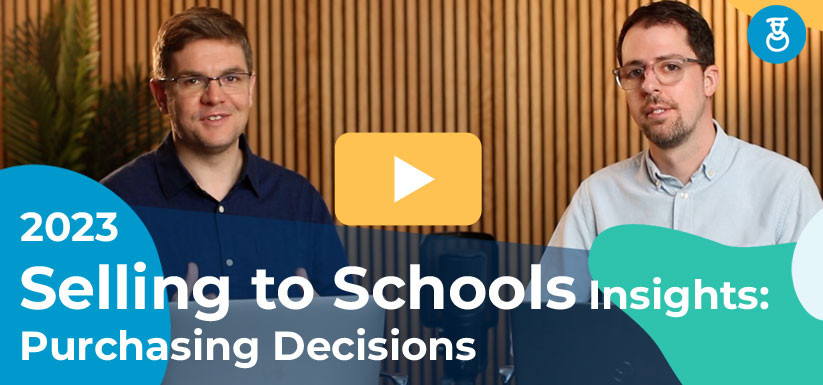

Everything You Need to Know About School Spending
Gain education insights from our State of Selling to Schools Report, about how schools make their purchasing decisions, when they buy, and who makes the decisions.
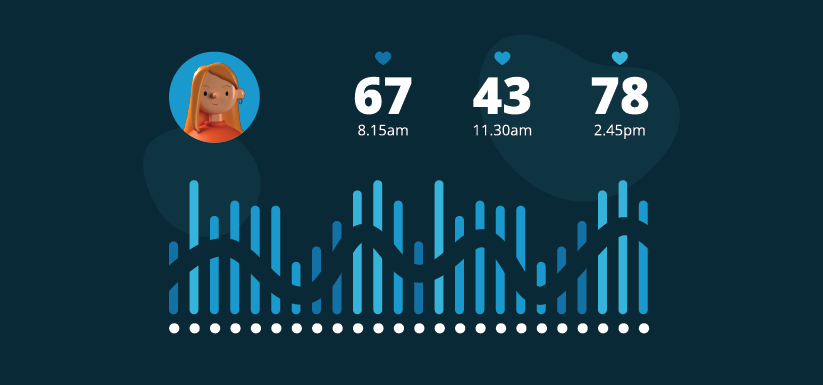

How your edu-marketing can support school staff wellbeing
Gain an insight into staff wellbeing to help you shape your marketing strategy into one that will help solve their problems and make you sales in the process.


Expert marketing to K-12 support and solutions
Expert marketing to K-12 solutions
Email Principals, Teachers, and District Staff Inboxes
Email teachers and staff inboxes
Sell More to US and Global Schools and Districts
Sell more to schools and districts















